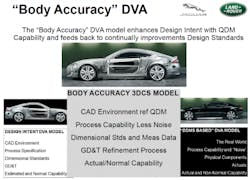"Closed-loop manufacturing" is a term those in the manufacturing industry hear frequently, but
many are unaware of exactly how it can be used to add value to their processes. The “loop” in closed-loop manufacturing refers to feedback, which in these processes cycles both upstream and downstream to inform the various stages of production. All manufacturing relies on data and measurements to drive productivity and ensure quality, but closed-loop manufacturing processes apply specific tools and concepts to improve production processes.
What is closed-loop manufacturing?
Collecting measurement data and utilizing it to continually identify issues to improve design quality are the key activities in closed-loop manufacturing. This data can be gathered during manufacturing and fed upstream to enhance future iterations of the process. When implemented effectively, closed-loop processes reduce tooling costs, improve accuracy and produce higher-quality parts on future designs.
To create a data-driven manufacturing process, the manufacturer needs to utilize simulation to validate their Geometric Dimensioning and Tolerancing (GD&T) and assembly processes to meet pre-defined, critical-to-quality characteristics. While workflows vary among manufacturers, simulation and feedback cycles are essential elements in any closed-loop manufacturing process.
First, engineers seek to predict nonconformance through simulation and reduce these issues through iterative design. Then they use the quality characteristics identified during simulation and tolerance analysis to create plans to measure key data points. Those data points are coordinated with corresponding points from computer-aided design (CAD) models. Ongoing inspection and measurement enables manufacturers to identify quality issues so that they can be addressed quickly. When an issue is observed, a Statistical Process Control (SPC) system identifies it and provides tools for root-cause analysis, and both the design and process are updated to resolve the issue and continually streamline the manufacturing process.
Key components
Every closed-loop manufacturing process begins with a plan, of course. To create an inspection plan, also known as a measurement plan, a manufacturer must first define the design requirements for the specific product. The digital thread, a communications framework that enables data flow among previously disconnected elements in a manufacturing process, begins with considering the CAD models. Some manufacturers mistakenly assume that general requirements represented in a non-validated virtual model are accurate enough, but any misrepresentations of the dimensional specifications (GD&T) can complicate the plan execution. Before measurement instructions are created, the dimensional specifications and tolerances (optimally GD&T callouts) should be verified and validated by a dimensional-simulation tool.
Conducting a dimensional analysis to verify requirements early in the product lifecycle enables manufacturers to focus on the quality areas that are most important to their products and process. This "Right Quality" optimizes GD&T on key areas for that particular product, tightening critical tolerances and relaxing requirements for less important details. Before creating an inspection plan, manufacturers should also analyze tolerances to determine allowable variance and identify any build issues. When issues are found in the early design stages, changes can be made more quickly and cost-effectively. It is important to identify critical-to-quality characteristics and tolerances because they will be used to inform the plant-quality team what needs to be measured and monitored.
An accurate, efficient inspection plan identifies the critical data necessary for maintaining high-quality production. The data generated from the inspection plan will serve as the basis for decision-making, so it is important that the appropriate measurements and collection methods are identified during the planning stages. Using fit-for-purpose software enables manufacturers to validate their inspection plans before implementing them.
Modern SPC systems are transforming the way quality managers approach measurement and inspection processes. Once an inspection plan has been validated, it can be implemented to feed data upstream and downstream to improve operational efficiency. A SPC system analyzes this data to determine its significance and make decisions. The business intelligence provided by the software is only as good as its inputs, which is why an efficient inspection plan is so important.
If the process is built upon validated requirements and collects appropriate, accurate data, then analysis and decision-making can be largely automated. Utilizing the findings from the analyzed data to update the design of the process completes the feedback loop.
Use case–Jaguar Land Rover
The company-wide implementation of global measurement data at Jaguar Land Rover demonstrates how closed-loop manufacturing processes can improve product quality.
Headquartered in the United Kingdom, Jaguar Land Rover is a global automotive manufacturer that produces more than 600,000 vehicles each year and employs some 40,000 people. The brand is utilizing an SPC system to collect, analyze and act upon production data to enhance its dimensional variation analysis (DVA) operations.
Challenge
The company's DVA team sought a solution to improve quality across all of its product families.
To determine the initial design-intent input, the Jaguar Land Rover DVA team uses ISO standards and guidelines to establish variation levels. These variation values and attributes are developed during the design phase to recognize specific requirements and the inherent dimensional capabilities of fabrication processes for each component. Their aim is to enhance design execution by implementing their Statistical Process Control (SPC) system to improve feedback loops. The end goal was to implement a modelling strategy that maintained the principles of design intent while incorporating relevant data from their SPC system to enhance accuracy and, ultimately, improve vehicle quality and line-rate speed and consistency.
Solution
To advance their dimensional-variation-analysis capabilities, Jaguar Land Rover partnered with Dimensional Control Systems of Troy, Michigan, USA, to implement a web-based Quality Data Management (QDM) SPC system. Offering various modules for customization, the purpose of this system is to collect, standardize and analyze measurement data to deliver actionable insights that improve production quality. This SPC solution features a centralized database and enables global access for Jaguar Land Rover. With multiple output formats and customizable reports, the QDM SPC system accommodates a wide range of demands from different stakeholders within the organization from shop floor to top management.
The QDM SPC system enhances the DVA team's ability to optimize design by integrating real-world measurement data. Jaguar Land Rover's design intents are created in a CAD environment, whereas the QDM system measures data in the manufacturing environment. The design intent determines the process specifications, while the SPC system evaluates the actual process capability.
Detailed data from the end of the manufacturing process can now be evaluated in proper context and utilized to refine the design requirements.
Jaguar Land Rover's process first assesses the CAD analysis results from their CAD simulation tools. Next, the SPC system analyzes the data it has received from actual measurements taken during the assembly process. The results from the CAD simulation and the SPC system are then correlated to determine whether significant variance exists. Jaguar Land Rover has set a tolerance of +/-10 percent to monitor for notable variation. When a significant variation is detected, the SPC data is aligned with the CAD model to identify the source of the discrepancies. These data comparisons are used to derive an optimum body-accuracy model, and the feedback from this process is incorporated to improve the design requirements.
Results
Implementing Dimensional Control Systems' QDM SPC system is assisting the DVA team with distinguishing significant variations from “noise.” In the manufacturing environment, there are many potential influences that contribute to process variations. The root-cause-analysis capabilities in the SPC system enable Jaguar Land Rover to differentiate between factors that would be beneficial to incorporate into their design models and those that should be excluded. Integrating relevant data from real-world performance improves the models’ abilities to reflect the actual vehicles.
The system has been adopted across the global organization, used daily by:
- Shop floors
- Engineering
- Dimensional Variation Analysis (DVA) team
- Manufacturing
- Quality
- Management
Like most manufacturers, Jaguar Land Rover has dimensional requirements. Their closed-loop manufacturing process provides far greater insight into their production capabilities, which help to drive future standards and goals.
By continuously collecting, analyzing, contextualizing and acting upon production data, Jaguar Land Rover is improving their design models. Producing more robust designs enables the manufacturer to draft better specifications and account for the real conditions in their assembly process. Ultimately, this leads to more efficient processes that produce higher-quality vehicles that are easier to manufacture.
Summary
Implementing a closed-loop manufacturing process requires carefully considering design requirements, establishing a detailed measurement plan and deploying the new process with support from appropriate software tools. With the right measurements, processes and tools, a manufacturer's systems can continuously gather and analyze production data on key variables.
Fit-for-purpose software tools facilitate building real-time feedback loops. Choosing a customizable system designed for manufacturing enables companies to collect, analyze and utilize data more efficiently, while improving comprehension and communication across the organization. While software is important, outputs are only as reliable as the inputs that they are derived from, so implementing a well-designed measurement plan is essential. Both the processes and measurement plans should continue to evolve as new data provides insights into actual performance.
An efficient closed-loop manufacturing process enables quick decision-making and rapid response to virtually any quality issue. Embracing a digital thread allows manufacturers to run more adaptable and flexible workflows that prioritize quality control. Investing in intelligence-backed processes generates continuous improvements that increase productivity and, ultimately, create better products.
Benjamin Reese is director of marketing with Dimensional Control Systems.





